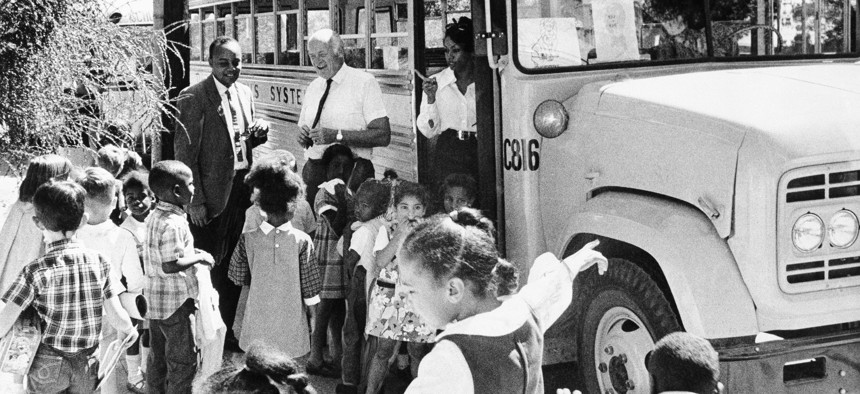There’s a Generational Shift in the Debate Over Busing

Young students head for a school bus in Berkeley, California on Feb. 24, 1970. AP Photo
COMMENTARY | Kamala Harris took part in a bold experiment as a child—and the experiences of her generation may transform the debate over desegregation.
During the second Democratic presidential debate, Senator Kamala Harris of California challenged former Vice President Joe Biden regarding a topic that has received little attention in recent presidential elections: school desegregation. Harris described Biden’s recent remarks in which he fondly recalled his “civil” working relationships with segregationist senators such as James O. Eastland of Mississippi and Herman E. Talmadge of Georgia as “hurtful.” “It was not only that, but you also worked with them to oppose busing,” Harris continued. “And you know, there was a little girl in California who was part of the second class to integrate her public schools, and she was bused to school every day. And that little girl was me.”
By invoking her own story, Harris highlighted a generational gap between people who lived through school desegregation as students and those, like Biden, for whom the feelings and opinions of white parents and constituents are paramount. As scholars such as Amy Stuart Wells and Rucker Johnson have shown, the generation of students who experienced school desegregation firsthand in the 1970s and 1980s benefited greatly. In public-policy debates and popular memory, though, the perspectives of students have been overshadowed by those of antibusing parents and politicians. As a result, the successes of school desegregation have been drowned out by a chorus of voices insisting busing was an inconvenient, unfair, and failed experiment.
When Harris boarded a school bus in the fall of 1969 to attend Thousand Oaks Elementary School in an affluent part of North Berkeley, busing was already a hot-button political issue. The controversy was driven by white opposition to school desegregation, not by the use of school buses. Students in the United States had long ridden buses to school. Buses made the modern public-school system possible, enabling multigrade elementary schools and comprehensive high schools to replace one-room schools. Buses had long been used in the South—as well as in New York, Boston, and many other northern cities—to maintain segregation. This form of transportation was not controversial for white parents. Put more starkly, school buses were fine for the majority of white families; busing was not.
White parents in New York City organized in the late 1950s to oppose plans to bus black and Puerto Rican students from overcrowded schools to white schools with open seats. The parents used euphemisms such as busing and neighborhood schools to maintain segregated schools without explicitly saying they did not want their children to go to school with black or Latinx students. Similar antibusing protests occurred in Boston, Chicago, Detroit, and other cities in the 1960s.
Northern congressmen responded to the anger expressed by many of their white constituents by writing antibusing provisions into the 1964 Civil Rights Act. These amendments were designed to keep federal civil-rights enforcement of school desegregation focused on the South and away from the North. While the Civil Rights Act finally pushed to the South to comply with Brown v. Board of Education by enabling the withholding of federal funds, cities in the North, Midwest, and West routinely flouted federal authority.
Antibusing rhetoric spiked in 1972, the year Joe Biden was elected to the U.S. Senate. White protesters such as Irene McCabe of Pontiac, Michigan, received massive amounts of media attention for their defiance of court-ordered school desegregation. President Richard Nixon called for Congress to pass a busing moratorium and used televised presidential addresses to signal that he would limit federal oversight to unconstitutional de jure segregation, most commonly associated with the South, to set the terms of the busing debate. Nixon also warned his appointees and the lawyers and officials who worked in the Justice Department and the Department of Health, Education, and Welfare that they could either support the administration’s evolving school-desegregation policies or lose their jobs. When Biden came to the Senate and began introducing his own antibusing amendments, he was building on more than 15 years of white parents and politicians using busing as a code word to oppose school desegregation.
Berkeley was able to craft a successful school-desegregation plan in this context because of strong local leadership and a sense of civic purpose. Starting in the 1950s, local civil-rights activists pushed the school board to address the overcrowded and unequal schools black students attended. They successfully elected several pro-integration members to the school board, which subsequently established a citizens’ committee to study segregation, implemented a plan to desegregate the city’s junior high schools, and tested a pilot busing program. As in other cities, these steps were controversial in Berkeley. A citizens’ group, the Parents Association for Neighborhood Schools, led an unsuccessful effort to recall the school board in 1964. Public debates and PTA meetings remained heated for the next several years.
Berkeley’s school superintendent, Neil Sullivan, was also a vocal supporter of school desegregation. Sullivan took the Berkeley job in 1964, after successfully opening free schools in Prince Edward County, Virginia, which had closed its public schools to avoid court-ordered desegregation, leaving black students without public education for four years.
Sullivan understood the importance of making a strong case for school integration. In his fall 1967 report to the school board, “Integration: A Plan for Berkeley,” he wrote, “School districts cannot now escape the moral obligation to attack this problem … The solution to the problem of segregation is not simple. But the Berkeley Unified School District does not shy away from difficult problems … In solving this problem, we will set an example for all the cities of America.” In January 1968, the school board voted unanimously to desegregate the city’s 14 elementary schools, and Sullivan’s plan was distributed to parents and community members to foster support for integration. Martin Luther King Jr. wrote that, upon learning about Berkeley’s bold integration plan, “hope returned to my soul and spirit.”
Berkeley’s plan for elementary-school desegregation started in September 1968, with more than one-third of the district’s 9,000 students riding buses. Unlike many cities that placed the burden of busing on black students, Berkeley implemented a two-way busing plan that involved black, white, Asian American, and Mexican American students. The plan quickly changed the racial demographics of the city’s schools. Thousand Oaks Elementary was 95 percent white and 3 percent black in 1963. When Harris started kindergarten in 1969, Thousand Oaks was 53 percent white and 40 percent black, and in no elementary school in Berkeley did any racial group comprise more than 60 percent of the students.
The Berkeley plan garnered national attention as a model for school desegregation. “Some Berkeley residents thought the roof was going to cave in when the city completely integrated its schools last fall,” the Los Angeles Times reported in July 1969. “Such has not been the case. After a full school year of operation, the ‘Berkeley Plan’ offers reassurance that mixing children racially in schools can work.”
The Berkeley school board has adapted its plan over the past five decades to respond to the changing racial demographics of the city. In 2004, the board adopted an approach that divides the city into more than 400 micro-neighborhoods and asks all families to submit their school choices. Student placements take both school diversity and family preferences into account, without looking at the race or ethnicity of any individual student. Berkeley’s innovative approach received renewed attention after the U.S. Supreme Court, in the 2007 case Parents Involved v. Seattle, ruled against using race as a factor in voluntary school-desegregation plans in Louisville, Kentucky, and Seattle. (Like Berkeley, Louisville has found creative ways to maintain diverse schools, despite the court’s ruling). The scholars Lisa Chavez and Erica Frankenberg argued in 2009, “The Berkeley plan is a proven success that has been very well received by the courts.”
The lesson of the Berkeley plan is that successful school-desegregation efforts require leaders to articulate clearly why integrated education is a civic good, to navigate the inevitable resistance from some parents, and to adapt plans to changing political and demographic realities. No desegregation plan is ever perfect, but innovative efforts that are given the time, resources, and support they need to succeed can make a real and lasting impact on students.
While antibusing politicians and parents dominated public discourse nationally, school officials and parents in Berkeley focused on how school buses could help enable a comprehensive desegregation plan to improve educational opportunities for students of color and low-income students. If school desegregation remains a topic of debate during the primary season, all the candidates would benefit from studying the Berkeley plan rather than rehashing debates over busing.
MATTHEW DELMONT is a professor of history at Dartmouth College. He is the author of Why Busing Failed: Race, Media, and the National Resistance to School Desegregation.
NEXT STORY: ‘I Do Wall’ Seeks to Change Perceptions of Local Government





